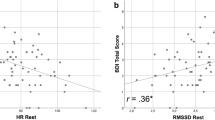Abstract
The purpose of the present study was to determine whether cardiovascular reactivity to mental stress may be comparable in sitting and standing postures. Fifteen healthy males performed two 1-min mental arithmetic tasks, either while sitting or while standing, in counterbalanced order. Heart rate, pulse transit time, and T-wave amplitude were recorded in the last 10 s of the minute before, during, and after the mental arithmetic. Reactivity scores for each of the dependent measures were computed by calculating the percentage change from baseline values. Data were analyzed with multivariate and univariate repeated measures analysis of variance. Heart rate reactivity to the combination of orthostatic and mental stress was greater than to either stressor alone. Cardiac-sympathetic reactivity was greater in response to orthostatic than to mental stress as revealed by greater changes in T-wave amplitude and pulse transit time in response to the former. No additional decreases in T-wave amplitude, in response to mental stress, were observed during standing, but pulse transit time decreased in the same situation. However, no changes in pulse transit time in response to mental stress were observed in the sitting position. These results demonstrate that cardiovascular reactivity to mental stress depends on the body position in which the stressor is encountered.
Similar content being viewed by others
References
Bevegard S, Holmgren A, Jonsson B (1960) The effect of body position on the circulation at rest and during exercise, with special reference to the influence on the stroke volume. Acta Physiol Scand 49:279–298
Brown TG, Szabo A, Seraganian P (1988) Physical versus psychological determinants of heart rate reactivity to mental arithmetic. Psychophysiology 25:532–537
Fillingim RB, Roth DL, Cook EW (1992) The effects of aerobic exercise on cardiovascular, facial EMG, and self-report response to emotional imagery. Psychosom Med 54:109–120
Furedy JJ (1987) Beyond heart rate in the cardiac psychophysiological assessment of mental effort: the T-wave amplitude component of the electrocardiogram. Hum Factors 29:183–194
Furedy JJ, Heslegrave RJ (1983) A consideration of recent criticisms of the T-wave amplitude index of myocardial sympathetic activity. Psychophysiology 20:204–211
Godin G, Jobin J, Bouillon J (1986) Assessment of leisure time exercise behavior by self-report: a concurrent validity study. Can J Publ Health 77:359–362
Goldstein IB, Shapiro D (1988) Cardiovascular responses to mental arithmetic and handgrip during different conditions of postural change. Psychophysiology 25:127–136
Hatch PJ, Klatt K, Porges SW, Schroeder-Jasheway L, Supik JD (1986) The relation between rhythmic cardiovascular variability and reactivity to orthostatic, cognitive and cold pressor stress. Psychophysiology 23:48–56
Heslegrave RJ, Furedy JJ (1979) Sensitivities of heart rate and T-wave amplitude for detecting cognitive and anticipatory stress. Physiol Behav 22:17–23
Heslegrave RJ, Furedy JJ (1983) On the utility of T-wave amplitude: a reply to Schwartz and Weiss. Psychophysiology 20:702–708
Hijzen TH, Van Der Gugten J, Bouter L (1984) Active and passive coping under different degrees of stress: effects on urinary and plasma catecholamines and ECG T-wave. Biol Psychol 18:23–32
Jamieson J, Howk S (1992) The law of initial values: a four factor theory. Int J Psychophysiol 12:53–61
LeBlanc J, Côté J, Jobin M, Labrie A (1979) Plasma catecholamines and cardiovascular responses to cold and mental activity. J Appl Physiol 47:1207–1211
Levi L (1965) The urinary output of adrenalin and noradrenalin during pleasant and unpleasant emotional states. Psychosom Med 27:80–86
Myrtek M, Spital S (1986) Psychophysiological response patterns to single, double, and triple stressors. Psychophysiology 23:663–671
Obrist PA, Gaebelein CJ, Teller ES, Langer AW, Grignolo A, Light KC, McCubbin JA (1978) The relationship among heart rate, carotid dPldt, and blood pressure in humans as a function of the type of stress. Psychophysiology 15:102–115
Péronnet F, Szabo A (1993) Sympathetic resonses to acute psychosocial stressor in humans: linkage to physical exercise and training. In: Seraganian P (ed) Exercise psychology: the influence of physical exercise on psychological processes. Wiley, New York, pp 172–217
Rau H (1991) Response of the T-wave amplitude as a function of active and passive tasks and beta-adrenergic blockade. Psychophysiology 28:231–239
Roth DL, Bachtler SD, Fillingim RB (1990) Acute emotional and cardiovascular effects of stressful mental work during aerobic exercise. Psychophysiology 27:694–701
Scher H, Furedy JJ, Heslegrave RJ (1984) Physic T-wave amplitude and heart rate changes as indices of mental effort and task incentive. Psychophysiology 21:326–333
Seraganian P, Roskies E, Hanley JA, Oseasohn R, Collu R (1987) Failure to alter psychophysiological reactivity in type A men with physical exercise or stress management programs. Psychol Health 1:195–213
Shulhan D, Scher H, Furedy JJ (1986) Phasic cardiac reactivity to psychological stress as a function of aerobic fitness level. Psychophysiology 23:562–566
Sinyor D, Schwartz SG, Péronnet F, Brisson G, Seraganian P (1983) Aerobic fitness level and reactivity to stress: physiological, biochemical and subjective measures. Psychosom Med 45:205–217
Stafford RW, Harris WS, Weissler AM (1970) Left ventricular systolic time intervals as indices of postural circulatory stress in man. Circulation 41:485–492
Szabo A, Gauvin L (1992) Mathematical performance before, during, and following cycling at workloads of low and moderate intensity. Percept Mot Skills 75:915–918
Weiss T, Del Bo A, Reichek N, Engelman K (1980) Pulse transit time in the analysis of autonomic nervous system effects on the cardiovascular system. Psychophysiology 17:202–207
Wilkinson L (1989) SYSTAT: the system for statistics. Systat Inc., Evanston
Ziegler MG (1980) Postural hypotension. Ann Res Med 31:239–245
Author information
Authors and Affiliations
Rights and permissions
About this article
Cite this article
Szabo, A. The combined effects of orthostatic and mental stress on heart rate, T-wave amplitude, and pulse transit time. Europ. J. Appl. Physiol. 67, 540–544 (1993). https://doi.org/10.1007/BF00241651
Accepted:
Issue Date:
DOI: https://doi.org/10.1007/BF00241651




